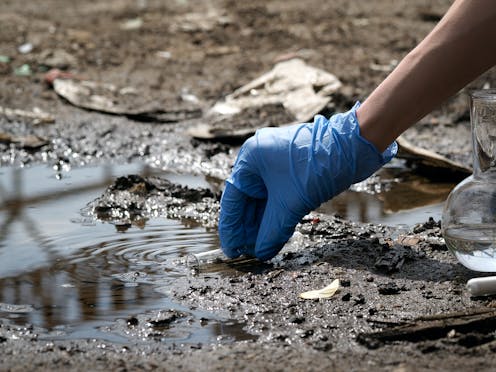
A person takes a sample of water for testing. Irina Kozorog / Shutterstock
Arsenic has long been considered “the king of poisons.” Films such as “Arsenic and Old Lace” by Frank Capra and “The Name of the Rose” by Jean-Jacques Annaud illustrate the deadly effect that a high dose has on people.
But when someone experiences arsenic poisoning, it’s usually not the direct result of a diabolical plot – in fact, it usually isn’t. So how do you figure out how the arsenic got into someone’s bloodstream?
That’s the question a team of fellow chemical engineers and I tackled more than 20 years ago after an abrupt jump in the number of U.S. cases of arsenic poisoning. We later published a peer-reviewed study documenting the investigation.
Finding the source of arsenic poisonings is not always easy, but it’s extremely important for public health. Scientists often need to combine science and detective work, which led us to conclude that landfills could be a significant source of contamination.
Yet nearly 20 years later, landfills in the U.S., Europe and around the world remain important sources of arsenic poisoning.
Exploring a mystery
Arsenic is a chemical element that occurs naturally in the environment. In its organic form, with a carbon molecule attached, it is harmless. But it is highly toxic in its inorganic form, without carbon. Inorganic arsenic is present in high levels in groundwater in 70 countries, including Chile, China, India, Mexico and the United States.
Prolonged exposure to inorganic arsenic, mainly through drinking water and food, can lead to chronic poisoning, the most characteristic effects of which are skin lesions and skin cancer.
In 2002, I was a visiting scholar at the University of Arizona studying anaerobic processes in nature – or those that occur without oxygen. My colleagues and I were focused on how anaerobic bacteria can change the number of electrons in arsenic, affecting its solubility. This is important because when arsenic is soluble, meaning it can dissolve in water or other liquids, it can become mobile.
We came across a report by the American Association of Poison Control Centers that found the number of arsenic poisonings in the U.S. jumped to 1,680 in 2001 from about 1,000 or fewer in previous years.
Based on that data, we set ourselves the goal of finding out where the arsenic may have come from and exploring what possible human-related activities were involved. To do so, we used the scientific method, which can be summarized in three stages: observation of a phenomenon, establishment of an explanatory hypothesis and validation with experimental results.
After observing the rise in arsenic cases in the data and considering a few possibilities, we hypothesized that arsenic might be escaping from city landfills and entering the American food supply via groundwater.
Arsenic is found in many household and industrial products, from pesticides and food additives to semiconductor chips and pharmaceuticals. And when disposed of, the arsenic in the products can leach from the landfill into the soil.
Investigating a hypothesis
To validate our hypothesis, we designed an experiment that used three biological reactors to simulate the chemical process of how an improperly maintained landfill could leach arsenic into the groundwater. Two of the reactors contained various mixtures of insoluble arsenic and organic and inorganic material, as well as anaerobic bacteria, while the third was used as a control without the bacteria.
About 250 days after our experiment began, we found that anaerobic bacteria and organic matter had transformed the insoluble arsenic, which wasn’t able to travel through water, into its soluble form, which could travel through water. This allowed it to move through the ground as contaminated water, or leachate, and eventually end up in groundwater. From there, the arsenic can find its way to humans via drinking water or the food chain, such as in rice crops or chicken eggs.
Illegal landfills that lack proper management, like this one in Italy, have become sources of arsenic and other heavy metals leaching into groundwater.
AP Photo/Salvatore Laporta
To determine what else might be going on here, we teamed up with the Department of Pharmacology and Toxicology at the University of Arizona. With their help, we detected the presence of cacodylic acid in the leachate. This compound exponentially multiplies the toxic effects of the leachate stream, such as by promoting tumors.
Consequently, poor sealing of landfills or operating them in a way that mixes inorganic and organic waste matter significantly increases the probability of a gradual release of heavy metals like arsenic in leachates, which can lead to both environmental and human harm.
The European Commission seems to be trying to take more aggressive action against illegal landfills, which are less likely to use appropriate safeguards, and recently announced it was referring Spain to the Court of Justice of the European Union for failing to ensure that its landfills – namely, 195 illegal ones – don’t endanger human health or harm the environment.
As our research suggests, the only ways to solve the problem of arsenic leaching into the food supply is by proper landfill design and management, which necessarily involves monitoring and treatment of the leachates they generate.
Moreover, I believe the implementation of a circular economy strategy – in which reuse and recycling are maximized – in the management of cities and in the individual behaviors of citizens would lead to a minimization of waste and also greatly reduce the potential release of toxic heavy metals such as arsenic from landfills.
Gumersindo Feijoo Costa does not work for, consult, own shares in or receive funding from any company or organization that would benefit from this article, and has disclosed no relevant affiliations beyond their academic appointment.
Advertisement

Advertisement
Contact Us
If you would like to place dofollow backlinks in our website or paid content reach out to info@qhubonews.com











